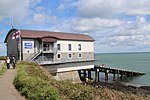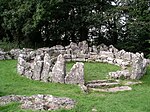Royal Charter Storm

The Royal Charter Storm (also known as the Great storm of 1859) of 25 and 26 October 1859 was considered to be the most severe storm to hit the Irish Sea in the 19th century, with a total death toll estimated at over 800. It takes its name from the Royal Charter ship, which was driven by the storm onto the east coast of Anglesey, Wales, with the loss of over 450 lives. The storm followed several days of unsettled weather. The first indications were seen in the English Channel about 3 p.m. on 25 October 1859, when there was a sudden increase in wind speed and a shift in its direction. There was extensive structural damage along the coasts of Devon and Cornwall. The storm drifted northwards, hitting Anglesey by about 8 p.m. and not reaching maximum force at the River Mersey until midday on 26 October, then continued northwards to affect Scotland. The winds reached force 12 on the Beaufort scale and were well over 100 mph (160 km/h). At the Mersey a wind pressure of 28 lbs per square foot (1340 Pa) was measured, more than ever previously recorded.
Excerpt from the Wikipedia article Royal Charter Storm (License: CC BY-SA 3.0, Authors, Images).Royal Charter Storm
Ffordd Cocsyn Richard Evans,
Geographical coordinates (GPS) Address Nearby Places Show on map
Geographical coordinates (GPS)
| Latitude | Longitude |
|---|---|
| N 53.354 ° | E -4.235 ° |
Address
Ffordd Cocsyn Richard Evans
Ffordd Cocsyn Richard Evans
LL72 8HS , Moelfre
Wales, United Kingdom
Open on Google Maps











